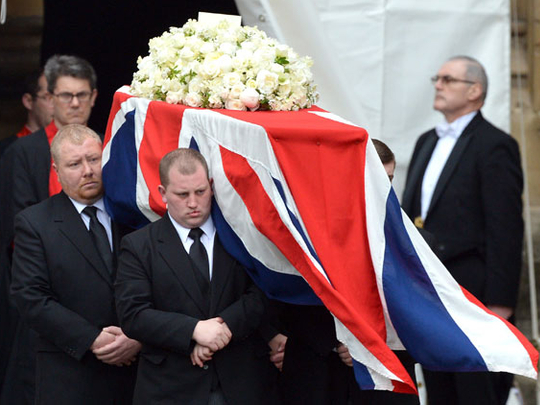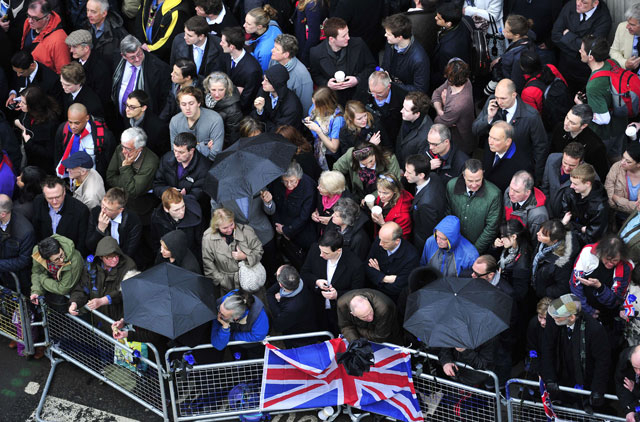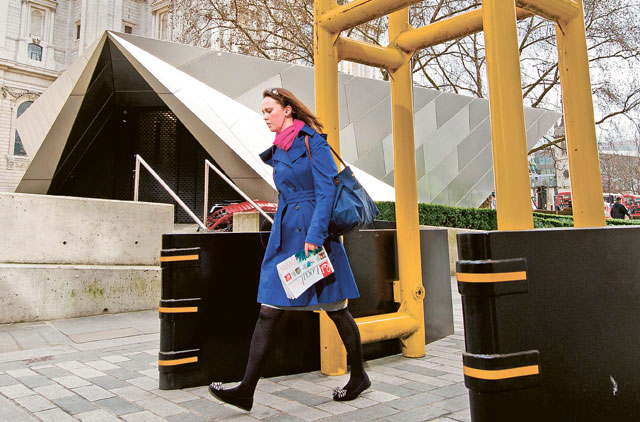
London: Margaret Thatcher made her final journey on Wednesday to St Paul's Cathedral for her funeral, where Queen Elizabeth II led mourners from 170 countries to bid farewell to one of Britain's most influential and divisive prime ministers.
Parliament's famous Big Ben bell was silenced as Thatcher's coffin draped in the Union Jack was carried to a hearse and driven through the streets of London lined by 700 soldiers, sailors and airmen in full ceremonial uniform.
Some 4,000 police officers have been deployed for the event, amid heightened security following the bombings at the Boston Marathon and fears of disruption by opponents of a politician who still arouses strong passions even in death.
Tens of thousands of well-wishers applauded as the cortege passed by in tribute to the "Iron Lady" who transformed Britain and helped end the Cold War during her 11 years in power.
The coffin, dressed with a bouquet of white flowers and a handwritten card reading "Beloved Mother - Always in Our Hearts", was taken to a chapel on the Strand before being transferred on to a gun carriage drawn by six black horses for the second leg of the procession to St Paul's.
A Royal Marines band led the way playing funeral marches by Chopin, Beethoven and Mendelssohn, while guns were fired every minute from the Tower of London.
"I wanted to pay my respects to the best prime minister since Churchill," said Gloria Martin, a property developer in her 60s with an array of "I Love Maggie" badges pinned to her chest.
"She was strong, she was resolute, and she put her country first above any idea of popularity. People admired her for that even if they didn't like Thatcher's policies."
The funeral, nine days after Thatcher died from a stroke aged 87, is the first time the queen has attended a prime ministerial funeral since Winston Churchill died in 1965.
The Falklands War, viewed by many of her admirers as Thatcher's finest hour, was a central theme of the ceremony with veterans of the 1982 conflict with Argentina walking behind her coffin.
Argentina was pointedly not represented among the 2,300 guests, who included US political figures Dick Cheney and Henry Kissinger, the prime ministers of Canada, Israel, Italy, Poland and Kuwait, and show business stars from Thatcher's time in power.
Current Prime Minister David Cameron and three former premiers, John Major, Tony Blair and Gordon Brown also joined the mourners along with all the current cabinet as well as all surviving members of Thatcher's cabinet and the opposition Labour leader.
But the pomp and splendour - paid for with millions of pounds of public money - have sparked criticism from those who argue that Thatcher was too polarising a figure to merit such a state-sponsored send-off.
Protesters in the crowd turned their backs as the funeral cortege went by to complain at the damage wrought by her radical free-market economic reforms, which created mass unemployment in Britain's industrial heartlands.
"We're spending 10 million pounds (11.7 million euros, $15.3 million) on it and that's disgraceful and unacceptable at a time of austerity," said 22-year-old student Casper Winslow, who held a placard reading "Rest of us in poverty".
Others shouted "waste of money" and booed at the funeral cortege.














